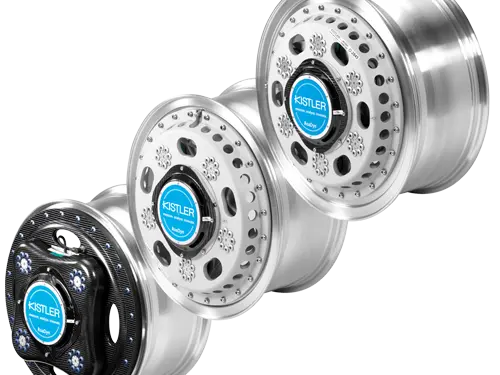What is a wheel force transducer used for?
Wheel force transducers are designed for use in the development and testing of complete chassis and chassis components of different vehicles such as passenger cars, SUV, commercial vehicles, race cars and industrial vehicles. During measurement, a wheel force transducer replaces a standard wheel and measures the forces and moments acting on the tire contact patch.
Wheel force transducers are used for a wide range of applications in vehicle development, to:
- Acquire road load data (RLDA: Road Load Data Acquisition)
- Verify design loads in the suspension of a vehicle
- Record and control data during chassis test rigs
- Iterate on multiaxial vehicle test benches
- Test tires
- Develop tires
What needs to be considered when using wheel force transducers?
Since the data of wheel force transducers are used for the development and dimensioning of parts relevant to safety, it is very important to ensure a high accuracy of the data.
This holds good especially for:
- The measurement of forces and moments of the rotating wheel
- The angle and angle velocity of the rotating wheel
The accuracy of the data measured by wheel force transducers are mainly defined by calibration procedures.
What are the advantages of wheel force transducers within vehicle development?
Using the interface loads from the road, the engineer designs a vehicle properly. This is because wheel force transducers measure the forces and moments directly at the interface between the wheel and the vehicle’s hub. There is no other component in between road and vehicle hub than the tire and the mechanical structure of the wheel force transducer, so this construction enables a rather direct transmission of loads.
During vehicle durability tests and on full-vehicle test stands such as street simulators, wheel force transducers ensure accurate testing and verification of load assumptions acquired from drive test conducted beforehand. For delivery of highly precise results: on the test stand, exactly the same load as measured before on the road is transmitted via the same interface and the same sensors into the vehicle.
Wheel force transducers deliver operating load data quickly and easily. The application of strain gauges represents an alternative method to measure operating loads. In this case, however, the vehicle components under test require specific preparations before one can measure. One has to bond the strain gauges to the components under test, and in addition, one also has to calibrate the components. All these further steps can be omitted by choosing the wheel transducer method.





